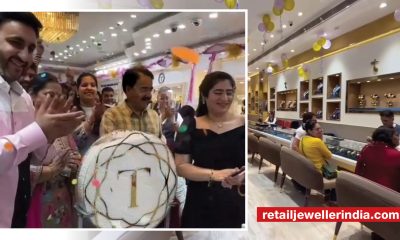Featured Articles
Are retailers maximizing the potential of a trade show visit?

With trade exhibitions gaining scale, jewellery retailers talk of the need for meticulous planning to organize their purchases, find strategic business opportunities and best utilize their time at these shows
When the concept of trade shows was yet to take off in the industry, retailers had to personally visit manufacturers, and after buying jewellery from them, take it back to their showrooms in boxes, a highly risky job in the absence of secure logistics that is par for the course today. Now, trade exhibitions have made life much easier for jewellers, who get to meet the country’s top manufacturers and vendors under one roof and buy the latest jewellery designs from them. With a lot of rigorousness and technology coming into play in the trade shows of today, considerable planning is required on the part of retailers, who depute entire teams to explore the innovations, find strategic business opportunities, seal purchases and make the most of these shows.
DEFINING THE NEED

Retailers need to plan their purchase well before a trade show. Based on customer demand, most jewellers make a detailed list of all their requirements, starting from the smallest of rings to the heaviest of sets, to be bought at a trade show. Talking of his own way of preparing for shows, Anil Talwar, Managing Partner, Talwarsons Jewellers, Chandigarh says, “We look at the previous year’s sales to find out the fast-selling and slow-moving products, and plan our purchases accordingly. As it is not possible to meet every exhibitor at a trade show, for the first couple of days, we try to visit our existing vendors and find out what they have come up with for the show. Then, we visit those manufacturers whose names we have heard but not had a chance to see their products. Lastly, while walking around, we venture into the stalls of any exhibitor who catches our attention.”

We look at the previous year’s sales to find out the fast-selling and slow-moving products, and plan our purchases accordingly. As it is not possible to meet every exhibitor at a trade show, for the first couple of days, we try to visit our existing vendors and then look at others
Anil Talwar Managing Partner Talwarsons Jewellers Chandigarh
For Ajay Talla, Founder, Talla Jewellers, Jammu preparation for any trade show begins with the senior management meeting store managers of all three stores of the brand, to find out what needs to be added to inventory for the upcoming season. The store managers come up with a list of items to be purchased from an exhibition, and after a lot of deliberation, a final buying list is prepared.

The accounts team then shares a brief of the company’s current cash reserves after which a final budget is prepared for the show. “Many times, the amount we need for the intended purchases is higher than planned. In such cases, we deliberate on which categories of jewellery are needed on an urgent basis and which can wait for some time. We also stop our buying almost 20-25 days before a major show to maintain a cash balance,” Talla says.

Many times, the amount we need for the intended purchases is higher than planned. In such cases, we deliberate on which categories of jewellery are needed on an urgent basis and which can wait for some time. We also stop our buying almost 20-25 days before a major show
Ajay Talla Founder Talla Jewellers Jammu
For any retail jewellery brand in the country, purchasing is centred around two major seasons – one starting with Akshay Tritiya and the other around Diwali. According to Amit Bandi, CEO, DP Jewel Line, Ratlam, when a retailer plans for an entire year, he knows what kind of products will be sold at what time, and there is a time-frame to procure those products at trade shows.

“When we plan for a show like IIJS Premiere or any other trade show, we ascertain the gap between available stock and ideal stock, and look to fill it up. For example, I would know what should be the stock of mangalsutra for the next three months, going by past sales, potential foreseen in that product and growth plans. New stores planned by the brand and BTL activity that could push the numbers also play a crucial role in formulating a purchase list for any trade show,” Bandi explains. He also points out the importance of sticking to a plan; for example, if a retailer has a requirement of 5 kg of gold, then he should buy that much, regardless of what he hears.

When we plan for a show like IIJS Premiere or any other trade show, we ascertain the gap between available stock and ideal stock, and look to fill it up. New stores planned by the brand and BTL activity that could push the numbers also play a crucial role in formulating a purchase list
Amit Bandi CEO DP Jewel Line Ratlam
According to Soumya Khurana, Director, Khurana Jewellery House, Amritsar, the preparation and planning for a trade show starts roughly one to two months before the date. “Our approach involves a well-coordinated effort among various teams, each led by different family members. As the trade show dates draw near, we plan our daily itineraries with our teams, assigning specific vendors to each day. This approach allows us to segregate responsibilities, with one team focusing on re-ordering from trusted vendors and another exploring new suppliers for fresh designs and innovations,” Khurana says. For them, order placement is a two-tier process, with one batch of products scheduled for immediate delivery and another set to be delivered within 30-45 days. “This strategy ensures efficient stock rotation, keeping our inventory dynamic and appealing to customers,” Khurana states

We plan our daily itineraries along with our teams, assigning specific vendors to each day. This approach allows us to segregate responsibilities, with one team focusing on re-ordering from trusted vendors and another exploring new suppliers for fresh designs and innovations
Soumya Khurana Director Khurana Jewellery House Amritsar
ROLE OF DIFFERENT TEAMS
According to Bandi, the formulation of a purchase list involves a lot of people. First, the back-end team prepares a list of items and shares it with the merchandise team, which then shares it with the purchase department for validation. The operations team is also involved in the process as they share the expected target numbers for the upcoming season and finally, the Board gives approval to the list. Store managers play an important role, sharing customer feedback to help finalize the purchase list. “We make it a point that our retail managers visit the shows, as it helps to maintain versatile designs in the store, and they start to think from the customer’s point of view,” Bandi says.

Before making big purchases at trade shows, the merchandising team of Karan Kothari Jewellers, Nagpur studies the category-wise sales report of the previous year and makes suggestions to the team on the basis of it. “Usually, 70% of the total sales happens from 30% of the inventory. So, before visiting any trade show, we figure out the 30% inventory which gives us the maximum sales and plan the purchases accordingly,” says Pradeep Kothari, Director, Karan Kothari Jewellers, Nagpur.

Usually, 70% of the total sales happens from 30% of the inventory. So, before visiting any trade show, we figure out the 30% inventory which gives us the maximum sales and plan the purchases accordingly
Pradeep Kothari Director Karan Kothari Jewellers Nagpur
For Khurana Jewellery House, it’s the design team that takes the lead, with extensive research to discern upcoming trends for the new season and drawing inspiration from previous successful designs. Collaborating closely with the store manager and sales specialists, the team analyses past sales records and existing inventory. This scrutiny helps them pinpoint categories that require restocking and identify items that did not resonate with the clientele. The team also actively engages with clients, seeking to know their expectations for the forthcoming season before heading to a trade show. This client-centric approach ensures that the inventory aligns with the customers.
Meanwhile, stock managers provide valuable insights into vendor performance, helping the management allocate resources judiciously for vendor interaction at the show. Armed with a list of participating vendors in advance, the team does its research to identify potential new vendors.
UTILISING TIME EFFICIENTLY
In order to maximize the available time at a trade show, the team from Talla Jewellers divides the vendors based on time slots, in 50% of the cases, taking prior appointments with them. Meetings with the remaining vendors is based on the outcome of business done with the first lot of vendors.
The team from DP Jewel Line too first meets the brand’s existing vendors and manufacturers, then looks for new designs by new vendors that have come into the market, and makes purchases accordingly. Before visiting a show, they make a list of vendors and location of their stalls, and split the team accordingly. “We have 60% appointments booked in advance to beat the rush at stalls. We also try to visit the hall with maximum number of vendors first,” Bandi says.
Sunder Jewellers usually spends three days at any exhibition. “On the first day, the team has to find the fastest-moving items. The second day is kept for checking out the latest collections of diamond and polki vendors. The last day is to explore what else the exhibition has to offer, and find new vendors to offer something new to our customers every season,” says Mehul Khurana, Managing Partner, Sunder Jewellers, Chandigarh.
For Khurana Jewellery House, the approach is to organize the days around individual vendors, and draw up a schedule hall-wise. Each day is dedicated to exploring a specific hall and covering all the vendors showcased within that hall. This approach significantly optimizes their time and maximizes their purchasing potential.
THE ACTUAL BUYERS
Talwar generally visits trade shows with a team of senior salespersons because, at the ground level, they are the ones who deal with customers daily. As for Talla, a team of five, consisting of the owner, and people from merchandising and sales take part in trade shows.

Before visiting any trade show, Karan Kothari Jewellers divides the team consisting of 20 members into four broad groups based on categories such as gold, diamond, silver and others. They identify the halls and stall numbers of the existing vendors and also book advance appointments with them so that the teams do not waste time waiting. Sometimes, depending on the ground situation, they further divide the teams into smaller groups to finish their tasks on time.
According to Mehul Khurana, all the buying is done by the owners of the company which includes him, his father and his brother. However, the sales heads of each counter help them figure out the requirements and let them know the demands of customers, so that they can buy accordingly. “Retailers should go with full clarity as to what they require, so that there is neither over-purchasing nor wrong purchasing of stock,” he says.
LEARNING FROM SHOWS
Trade shows are not just about jewellery purchase; they bring professionals together to witness the latest developments in the industry, exchange ideas and network with peers. Aayush Khurana, Director, Khurana Jewellery House, Amritsar, is one retailer who looks forward to widening his knowledge at trade shows. “These shows not only give retailers a glimpse into the ever-evolving industry landscape, but also empower them to bring fresh designs and experiences to their clients,” he says.
Talwar feels that shows like IIJS are a great platform for young retailers to gain practical knowledge first hand, which they would not get anywhere else.
Written By: Manoj Chakraborty







 Daily News2 months ago
Daily News2 months agoPC Jeweller to subdivide shares with 1:10 stock split amid record-breaking growth

 Daily News2 months ago
Daily News2 months agoKalyan Jewellers unveils limited edition ‘Pushpa’ collection ahead of Pushpa 2 release

 Daily News2 months ago
Daily News2 months agoBhima Jewellery sets Guinness World Record with ₹200 Crore Single-Day Sales on centenary celebration

 Exclusive2 months ago
Exclusive2 months agoMK Jewels’ Pink Tag Offer sparks 20 per cent sales growth across stores























